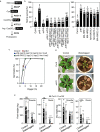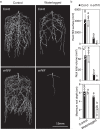ERFVII action and modulation through oxygen-sensing in Arabidopsis thaliana
- PMID: 37537157
- PMCID: PMC10400637
- DOI: 10.1038/s41467-023-40366-y
ERFVII action and modulation through oxygen-sensing in Arabidopsis thaliana
Abstract
Oxygen is a key signalling component of plant biology, and whilst an oxygen-sensing mechanism was previously described in Arabidopsis thaliana, key features of the associated PLANT CYSTEINE OXIDASE (PCO) N-degron pathway and Group VII ETHYLENE RESPONSE FACTOR (ERFVII) transcription factor substrates remain untested or unknown. We demonstrate that ERFVIIs show non-autonomous activation of root hypoxia tolerance and are essential for root development and survival under oxygen limiting conditions in soil. We determine the combined effects of ERFVIIs in controlling gene expression and define genetic and environmental components required for proteasome-dependent oxygen-regulated stability of ERFVIIs through the PCO N-degron pathway. Using a plant extract, unexpected amino-terminal cysteine sulphonic acid oxidation level of ERFVIIs was observed, suggesting a requirement for additional enzymatic activity within the pathway. Our results provide a holistic understanding of the properties, functions and readouts of this oxygen-sensing mechanism defined through its role in modulating ERFVII stability.
© 2023. Springer Nature Limited.
Conflict of interest statement
The authors declare no competing interests.
Figures






References
-
- Hammarlund EU, Flashman E, Mohlin S, Licausi F. Oxygen-sensing mechanisms across eukaryotic kingdoms and their roles in complex multicellularity. Science. 2020;370:eaba3512. - PubMed
-
- Holdsworth MJ, Gibbs DJ. Comparative Biology of Oxygen Sensing in Plants and Animals. Curr. Biol. 2020;30:R362–R369. - PubMed
-
- Bailey-Serres J, et al. Making sense of low oxygen sensing. Trends Plant Sci. 2012;17:129–138. - PubMed
-
- Licausi F, et al. Oxygen sensing in plants is mediated by an N-end rule pathway for protein destabilization. Nature. 2011;479:419–422. - PubMed
Publication types
MeSH terms
Substances
Grants and funding
LinkOut - more resources
Full Text Sources

